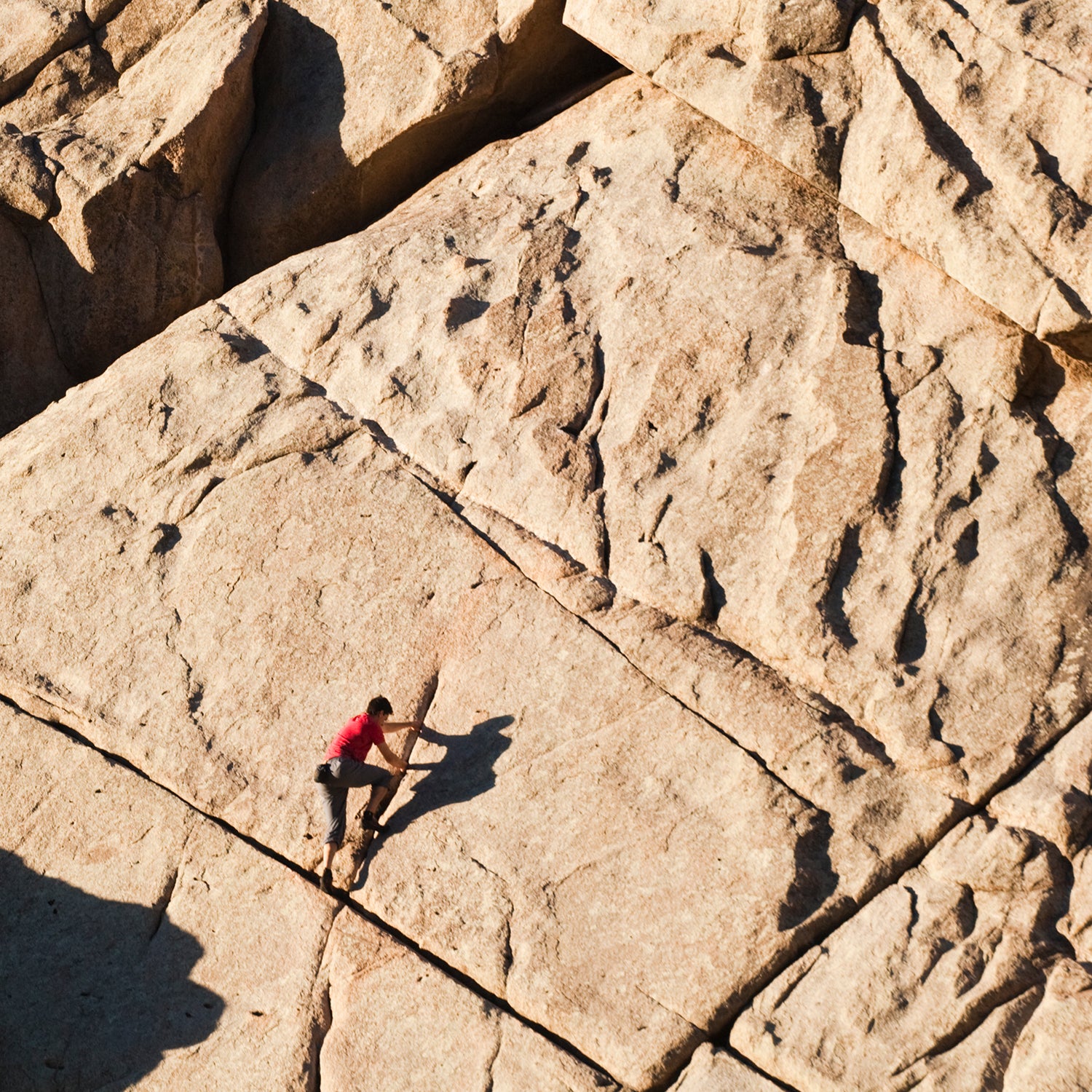A few minutes before 7 a.m. on July 14, Page Weil, 34, stopped to catch his breath halfway up Happy Hour Crag, in Boulder Canyon, on (5.7). The water resources engineer had passed the initial series of friendly block ledges and plugged a cam into a crack on the trad route as protection in case of a fall. The next few moves would be trickier, with the almost-smooth wall split by the thin, vertical seam. After gingerly testing several holds, Weil finally decided to commit to the crack, pulling on the sides with his fingertips as he smeared his toes against the slick granite, propelling himself upward.
To trad climb is to be faced with hundreds of such split-second micro decisions, the consequences of which can be fatal. That emphasis on human judgment and its fallibility intrigued , a psychology professor at North Carolina State University. An attention and behavior researcher, she set out to model how and why rock climbers make decisions, and she’d recruited Weil and 31 other trad climbers to contribute data to the project.
The idea for the study first came about at the crag. In 2011, McLaughlin, , a psychology professor at Colorado State University, and John Keller, an engineer at Alion Science and Technology, converged in Las Vegas for the conference, an annual event that brings together various professionals practicing user-focused product design. With Red Rocks just a few minutes away, the three avid climbers were eager to get some time on the rock before the day’s sessions, says Keller, even if it meant starting at 3 a.m.
McLaughlin had long been impressed by Wickens’s research, which focused on developing computational models of decision-making by studying professionals like scrub nurses and airline pilots. By recording their gaze patterns and interviewing them about their thought processes during surgery or while landing a plane, Wickens identified a model of human behavior that predicts what people pay attention to, as well as the factors that can disrupt their attention.
After climbing together, McLaughlin realized that the decisions made while climbing and flying a plane were similar, and subject to the same lapses in judgment. For example, both climbers and pilots require a substantial amount of specialized training to hone their crafts, yet both fall prey to overconfidence, switching into autopilot when their tasks become routine, especially if they’re tired or facing a time limit. “Both are subject to ‘get done-itis,’” says McLaughlin. “You want to summit or you want to land. You want to get home.” Some of the results are obvious: for example, studies have found that commercial pilots get distracted when they’re made to work around loud noises or with a tight deadline, and as a result, they make worse decisions and work less confidently. After a plane crash, McLaughlin says, we know that attention (or lack thereof) could have played a role in the outcome. The American Alpine Club's annual Accidents in North American Climbing report cites decision making as one probable cause of climbing accidents. What McLaughlin wanted was to figure out how attention actually worked, and if there were techniques to prevent it from slipping in crux situations.
When it comes to trad climbing, experience isn’t just about how long you’ve been climbing, or your strength—it’s also about your adeptness with gear placement and your confidence, both of which improve with practice.
In July, the team set out to find answers. McLaughlin recruited local climbers to climb I, Robot with a GoPro camera mounted on the front of their helmets and a 360-degree camera on top. Throughout the fall, the researchers will probe the footage they collected to create a heat map that shows which hand and foot holds climbers used, which they did not, and what they looked at while on the rock. McLaughlin also interviewed each climber to get a glimpse into their mental game. After Weil topped out, McLaughlin guided him over to a flat patch of rock for a debrief, where the two rewatched Weil’s GoPro footage as he narrated what was going through his head during the climb. By comparing climbers’ thoughts with footage of what they actually did, the researchers plan to build models of how climbers’ attention shifted throughout the climb and how that shift manifested itself on the wall.
Uncovering these patterns of behavior may help predict or even prevent accidents, says Wickens. For example, researchers might observe that climbers are more likely to wait longer to place protection if they find the climb to be easy or boring. Wickens likens a potential climbing analysis to investigations of plane crashes. “A retrospective analysis can diagnose how the pilot’s scan was abnormal or maladaptive—what were they doing differently that may have contributed to the situation?” he says. Of course, determining the exact cause of climbing accidents will be impossible unless climbers record every climb, and not every accident can be traced back to a lack of attention, but by collecting data about climbers’ decision making, Wickens hopes we’ll be better able to infer why and how some accidents happened.
When it comes to trad climbing, experience isn’t just about how long you’ve been climbing, or your strength—it’s also about your adeptness with gear placement and your confidence, both of which improve with practice. In the beginning, they take a colossal amount of mental resources. “Attention is a discrete resource; once it’s consumed, you can’t get more of it,” says McLaughlin. “If you’re novice, so much is consumed by ‘How the hell do I get gear to sit right?’ or ‘Which piece do I place?’ and then some is consumed by ‘Oh my god, I’m going to fall,’ whereas an expert just requires less attention.”
Unsurprisingly, McLaughlin predicts that novice tradsters will be more likely to have tunnel vision on the wall, looking only at the chunk of rock in front of them, rather than searching for placements. In contrast, expert trad climbers quickly identify holds and placements. Some can just look at a crack and know what gear to place. “When I’m walking on the sidewalk, I think about gear placements,” McLaughlin says. “You can’t stop it. You’re like, ‘That’s a good hold,’ or ‘I could get a #3 cam in there.’”
While nothing can replace direct climbing experience, McLaughlin envisions that her climbing data could be used to develop training programs, simulations, or even augmented-reality devices that teach novices to identify good holds. A computer model would highlight spots far out to the side, or just above their heads—areas that a beginner might otherwise miss.
While nothing can replace direct climbing experience, McLaughlin envisions that her climbing data could be used to develop training programs, simulations, or even augmented-reality devices that teach novices to identify good holds.
Beyond their applications to climbers, these results could improve our understanding of human decision-making under stressful, changing conditions, says Keller. Currently, human factors researchers have fairly accurate models of how people direct their attention in controlled, static environments. Take when a pilot is landing a plane—the terrain outside a plane may be changing, but the instrument panels and controls remain the same. A climber, on the other hand, is faced with new terrain throughout her task. If McLaughlin’s models are successful, they could serve as a jumping-off point for understanding human behavior in other dynamic environments: say, a paratrooper trying to land or a rescue worker combing through rubble. “Imagine augmented reality where likely-to-be-missed but important attributes get highlighted through the special glasses they are wearing,” McLaughlin says. The same algorithms McLaughlin, Keller, and Wickens use to highlight good holds can also be applied to highlight subtle cues a person might miss in a disaster situation, like a small strip of human clothing or slight movement beneath debris. “If we know what attracts attention, we can design systems to make sure they put their attention in the right place,” McLaughlin says. That “right place” may not be a single physical location, but perhaps a mental one: models of human attention could indicate how to help people focus that attention so they make better decisions and maybe avoid accidents.
If that all sounds far-fetched, well, it is for now. McLaughlin has only scratched the surface of what will be a massive, multi-month data analysis. On average, Wickens says, climbers completed I, Robot in between 12 to 15 minutes. Given that the human eye moves around three times a second, the researchers will have thousands of data points to crunch. “We’ll be able to cut and slice this info many different ways,” Keller says. The researchers plan to release their findings later this fall.
In the meantime, if you want to get better at climbing, your best bet is to do it the old-fashioned way: hit the crag.


